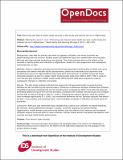| dc.contributor.author | Peters, David H | |
| dc.contributor.author | Singh, Lakhwinder P | |
| dc.contributor.author | Kumar, Binay | |
| dc.contributor.author | Pakzad, Iqbalshah | |
| dc.contributor.author | Aman, Iqbal | |
| dc.contributor.author | Steinhardt, Laura C | |
| dc.coverage.spatial | Afghanistan | en_GB |
| dc.date.accessioned | 2014-07-25T14:51:26Z | |
| dc.date.available | 2014-07-25T14:51:26Z | |
| dc.date.issued | 2011-08-01 | |
| dc.identifier.citation | Steinhardt, Laura C., et al. "Removing user fees for basic health services: a pilot study and national roll-out in Afghanistan." Health policy and planning 26.suppl 2 (2011): ii92-ii103. | en_GB |
| dc.identifier.issn | 0268-1080 | |
| dc.identifier.uri | https://opendocs.ids.ac.uk/opendocs/handle/20.500.12413/4207 | |
| dc.description.abstract | Background User fees for primary care tend to suppress utilization, and many countries are experimenting with fee removal. Studies show that additional inputs are needed after removing fees, although well-documented experiences are lacking. This study presents data on the effects of fee removal on facility quality and utilization in Afghanistan, based on a pilot experiment and subsequent nationwide ban on fees.
Methods Data on utilization and observed structural and perceived overall quality of health care were compared from before-and-after facility assessments, patient exit interviews and catchment area household surveys from eight facilities where fees were removed and 14 facilities where fee levels remained constant, as part of a larger health financing pilot study from 2005 to 2007. After a national user fee ban was instituted in 2008, health facility administrative data were analysed to assess subsequent changes in utilization and quality.
Results The pilot study analysis indicated that observed and perceived quality increased across facilities but did not differ by fee removal status. Difference-in-difference analysis showed that utilization at facilities previously charging both service and drug fees increased by 400% more after fee removal, prompting additional inputs from service providers, compared with facilities that previously only charged service fees or had no change in fees (P = 0.001). Following the national fee ban, visits for curative care increased significantly (P < 0.001), but institutional deliveries did not. Services typically free before the ban—immunization and antenatal care—had immediate increases in utilization but these were not sustained.
Conclusion Both pilot and nationwide data indicated that curative care utilization increased following fee removal, without differential changes in quality. Concerns raised by non-governmental organizations, health workers and community leaders over the effects of lost revenue and increased utilization require continued effort to raise revenues, monitor health worker and patient perceptions, and carefully manage health facility performance. | en_GB |
| dc.description.sponsorship | UKaid | en_GB |
| dc.language.iso | en | en_GB |
| dc.publisher | Oxford | en_GB |
| dc.rights.uri | http://www.ids.ac.uk/files/dmfile/IDSOpenDocsStandardTermsOfUse.pdf | en_GB |
| dc.subject | Health | en_GB |
| dc.title | Removing user fees for basic health services: a pilot study and national roll-out in Afghanistan | en_GB |
| dc.type | Article | en_GB |
| dc.rights.holder | The authors | en_GB |
| dc.identifier.externaluri | http://heapol.oxfordjournals.org/content/26/suppl_2/ii92.short | en_GB |

